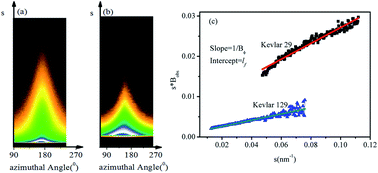In situ synchrotron small- and wide-angle X-ray study on the structural evolution of Kevlar fiber under uniaxial stretching
Abstract
The structural evolution and mechanism of Kevlar 29 and Kevlar 129 (poly(p-phenylene terephthalamide)) fibers during stretching were studied by in situ synchrotron small-angle X-ray scattering (SAXS) and wide-angle X-ray scattering (WAXS). Compared with Kevlar 29, the tensile strength of Kevlar 129 increased, while the elongation-to-break ratio decreased. SAXS results showed that ordered lamellae were observed only in Kevlar 29. The fibril length of Kevlar 129 was larger than that of Kevlar 29; however, the fibril misorientation width of Kevlar 129 was smaller. During stretching, both the fibril length and fibril misorientation width decreased at low strains, and then increased until the fibrils broke both in Kevlar 29 and Kevlar 129 fibers. From WAXS results, the crystal orientation angle decreased in Kevlar 29 during stretching, while that in Kevlar 129 increased at low strains and then decreased until the fibers broke. The change of crystallinity indicated that the amorphous phase can convert to the crystal phase at high strains, although the conversion ratio was not large. By combining the SAXS and WAXS results, a potential mechanism for Kevlar fibers during stretching was proposed.


 Please wait while we load your content...
Please wait while we load your content...